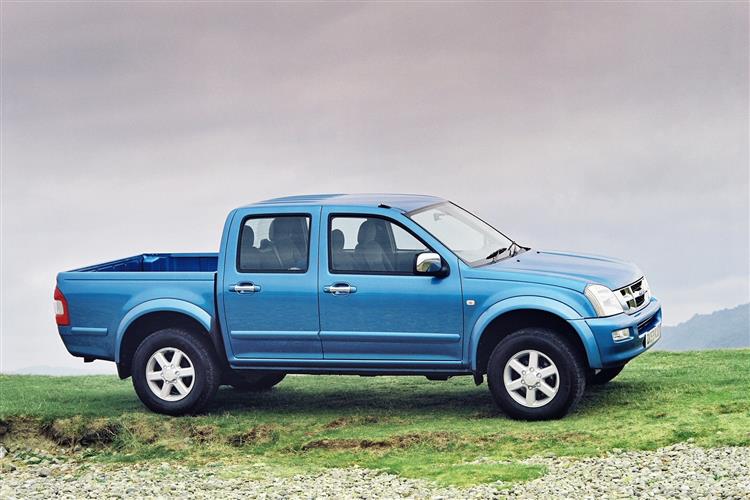BUCKING THE TREND (some text hidden) --NONE--
By Steve Walker
Introductionword count: 124
In the UK, we're quite proud of the boom in our pick-up truck market that took place in the early years of this century. The trend was driven by the double-cab pick-up's commercial vehicle tax status that allowed businesses and company car users to save a packet in tax by running one instead of a conventional car. At the time, the sector's growth was described as an explosion and lots of manufacturers rushed to take advantage but in global terms, sales levels only really increased from a drip, drip, drip to a trickle. In certain regions of the world, the pick-up reigns supreme and the vehicle we know as the Isuzu Rodeo will be a far more familiar sight elsewhere than it is here.
Modelsword count: 15
Models Covered: (2/4dr pick-up truck 2.5, 3.0 diesel [standard, Denver, Denver Max LE, LE Sport])
Historyword count: 355
Badged as the Isuzu D-MAX, Isuzu LB, Chevrolet Colorado, Holden Colorado and Holden Rodeo amongst other things, the Isuzu Rodeo that launched in the UK in 2002 was also sold in 130 other markets around the world. The cars that made it to these shores were built in Thailand where they were selling 10,000 a month for the initial period when it went on sale. What would UK importers International Motors have given for figures like that? The Rodeo arrived into a UK pick-up market that was really taking off. Models like the Mitsubishi L200, Nissan Navara and Toyota HiLux were the established players and the tough, workhorse pick-ups that Isuzu had been offering up to that point couldn't compete. The boom was focused on plush double-cab models with space for five and car-like equipment levels that people could use as working vehicles and family transport. That was the sector where the Isuzu Rodeo was introduced. Launched in 2002, the Rodeo range was supplemented at regular intervals by various special edition models. Amongst the highlights were the Rodeo Denver Max LE which showed up in 2005 and the Rodeo LE Sport (with DVD player and Satellite Navigation) of 2008. Used buyers will also encounter models fitted with Prodrive Performance Packs or PPPs. These were offered on certain models to up the power and torque ratings of the engines. A key point to remember for Rodeo used buyers is 2007 when the model received a major facelift with revised styling and a new 2.5-litre common-rail diesel engine that replaced the old direct injection unit of the same capacity. Then, in 2008, a 3.0-litre common-rail diesel engine was introduced, replacing the old 3.0-litre unit in the range-topping models, and an entry-level front-wheel-drive single cab pick-up arrived to prop-up the range. The Rodeo was competitive against the best UK market pick-ups for the early part of its lifecycle but began to fall behind around 2006 when Mitsubishi, Toyota and Nissan unveiled brand-new versions of their products. After that and even with its improved engines, the Isuzu was reduced to campaigning on more of a value for money ticket.
What You Getword count: 401
There was plenty of evidence that might have led you to suspect that Isuzu had a top-notch pick-up truck somewhere in their locker. The marque had become famed for its expertise in diesel engine technology and 4x4 vehicles were also something of a forte. After all, even the long-serving Trooper 4x4 established a loyal cult following by virtue of its rugged mechanicals. All the manufacturer had to do was pull the two areas together, adding a little pizzazz in the process. On appearances alone, the Rodeo could mix it with the best in the sector. Yes, there's the universal combination of large grille, big wheels and business-like stance but the Rodeo successfully differentiated itself from competitors with oversize headlamps that arc up well into the bonnet line. The wheelarches have a sharpness about them too, flaring dramatically and continuing on down to the very base of the thick front bumper. At the back, the loadbay integrates well with the cab, ending in a subtle flourish courtesy of a minor lip spoiler and wrap-around taillights. The top-spec models can be identified by alloy wheels and a liberally chromed front grille. In keeping up appearances on the outside, pick-up designers often let interior issues slip. The Rodeo offers a reasonable standard of materials inside but with emphasis more on tough build than a classy look and feel. The level of specification was more impressive. Safety equipment is strong across the Rodeo range with ABS, EBD, two front airbags, front seatbelt pre-tensioners and three-point belts throughout. Standard models have a radio CD player, immobiliser and wipers with four (count 'em) different speeds. The Denver, meanwhile, offered electric mirrors, fog lamps, keyless entry, a six-speaker sound system, air-conditioning and upgraded trim, along with an optional four-speed automatic transmission. If you view your pick up as a tool of the trade rather than as a frivolous lifestyle accessory, you'll be more interested in the Rodeo's offroad prowess than its ability to turn-heads on the high-street. All models have limited slip differentials, there is extensive under body shielding and the rear axle has an integral snorkel for navigating deep water. Payloads of around 1,000kg are possible, depending on whether you go for the single or double cab. The maximum towing limit is a hefty 3,000kg and the kerb-to-kerb turning circle is 12.2 meters for the 4x4 model - not bad for a vehicle of the Rodeo's size.
To see the full road test text contact us on 0330 0020 227
Pictures (high res disabled)

Scoring (subset of scores)
Category: Pick-Ups
| Performance | |
| Handling | |
| Comfort | |
| Space | |
| Styling, Build, Value, Equipment, Depreciation, Handling, Insurance and Total scores are available with our full data feed. | |



